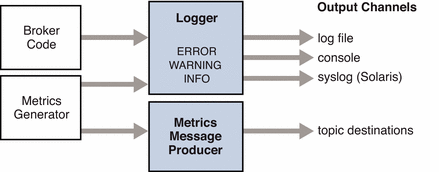Monitoring Services
The broker includes components for monitoring and diagnosing application and broker performance. These include the following:
-
Components that generate data, a Metrics Generator and broker code that logs events
-
A Logger component that writes out information to a number of output channels
-
A Metrics Message Producer that sends JMS messages containing metric information to topic destinations for consumption by JMS monitoring clients
The general scheme is illustrated in Figure 4–3. Broker properties for configuring the monitoring services are listed under Monitoring Properties.
Figure 4–3 Monitoring Support

Metrics Generator
The Metrics Generator provides information about broker activity, such as message flow in and out of the broker, the number of messages in broker memory and the memory they consume, the number of open connections, and the number of threads being used. The boolean broker property imq.metrics.enabled controls whether such information is logged; imq.metrics.interval specifies how often.
Logger
The Logger takes information generated by broker code and the Metrics Generator and writes that information to standard output (the console), to a log file, and, on Solaris platforms, to the syslog daemon process in case of errors. The log file to use is identified by the imq.log.file.dirpath and imq.log.file.filename broker properties; imq.log.console.stream specifies whether console output is directed to stdout or stderr.
The imq.log.level property controls the categories of metric information that the Logger gathers: ERROR, WARNING, or INFO. Each level includes those above it, so if you specify, for example, WARNING as the logging level, error messages will be logged as well. The imq.log.console.output and imq.log.file.output properties control which of the specified categories will be written to the console and the log file, respectively. In this case, however, the categories do not include those above them; so if you want, for instance, both errors and warnings written to the log file and informational messages to the console, you must explicitly set imq.log.file.output to ERROR|WARNING and imq.log.console.output to INFO. On Solaris platforms another property, imq.log.syslog.output, specifies the categories of metric information to be written to the syslog daemon. There is also an imq.destination.logDeadMsgs property that specifies whether to log when dead messages are discarded or moved to the dead message queue.
In the case of a log file, you can specify the point at which the file is closed and output is rolled over to a new file. Once the log file reaches a specified size (imq.log.file.rolloverbytes) or age (imq.log.file.rolloversecs), it is saved and a new log file created.
See Monitoring Properties for additional broker properties related to logging, and Configuring and Using Broker Logging for further details about how to configure the Logger and how to use it to obtain performance information.
Metrics Message Producer (Enterprise Edition)
The Metrics Message Producer receives information from the Metrics Generator at regular intervals and writes the information into metrics messages, which it then sends to one of a number of metric topic destinations, depending on the type of metric information contained in the message (see Table 4–2). Message Queue clients subscribed to these metric topic destinations can consume the messages and process the metric data they contain. This allows developers to create custom monitoring tools to support messaging applications. For details of the metric quantities reported in each type of metrics message, see the Message Queue Developer's Guide for Java Clients.
Table 4–2 Metric Topic Destinations|
Topic Name | |
|---|---|
|
mq.metrics.broker |
Broker metrics |
|
mq.metrics.jvm |
Java Virtual Machine metrics |
|
mq.metrics.destination_list |
List of destinations and their types |
|
mq.metrics.destination.queue.queueName |
Destination metrics for specified queue |
|
mq.metrics.destination.topic.topicName |
Destination metrics for specified topic |
The broker properties imq.metrics.topic.enabled and imq.metrics.topic.interval control, respectively, whether messages are sent to metric topic destinations and how often. The imq.metrics.topic.timetolive and imq.metrics.topic.persist properties specify the lifetime of such messages and whether they are persistent.
Besides the information contained in the body of a metrics message, the header of each message includes properties that provide the following additional information:
-
The message type
-
The address (host name and port number) of the broker that sent the message
-
The time the metric sample was taken
These properties are useful to client applications that process metrics messages of different types or from different brokers.
- © 2010, Oracle Corporation and/or its affiliates
